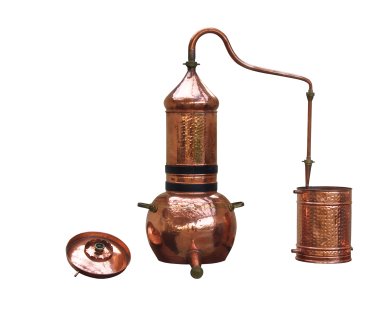
The earliest references we have to something resembling distillation or evaporation can be found in water-scarce areas of the Egyptian empire, where water was boiled in cauldrons and the droplets that formed on the lids were collected to be consumed.
The first known distillation technology is the alembic, and its earliest documented uses were alchemical, meaning they were used in attempts to transform chemical elements into more valuable ones. Obviously, this application lacked a scientific basis, and it was not until years later that it began to be used to separate dissolved chemical elements in water and in the preparation of recipes.
The first of the great revolutions came in the 8th century when Abu Mussah-al-Sofi first described more advanced methods of evaporation, as well as other separation techniques such as filtration and sublimation. During these years, work was also done to improve the materials used to manufacture the devices.
This led to a significant improvement in the production of perfumes and alcohols, such as the distillation of rose water through steam distillation.
Throughout the rest of the Middle Ages, there is evidence of the distillation of alcohol, nitric acid, and other products in major centers of knowledge, such as monasteries and some student centers in the great cities of old Europe. However, in places like Cairo, the distillation and storage of gasoline were carried out during the 11th century, which suggests that refined techniques and large-scale applications, such as gallery furnaces, refractory materials, and highly efficient condensers, must have existed.
After the Middle Ages, the coil was developed around a tube through which the vapor to be condensed passed, allowing for the recovery of low boiling point liquids and the large-scale production of 96% alcohol, also leading to the emergence of high-proof liquors. The ability to generate alcohol and acids on a large scale evolved the field of chemistry, and the properties of acids, bases, organic solvents, and other types of compounds were studied.
During the Industrial Revolution, steam was first used to transfer heat to other bodies, thanks to the discoveries of Rumford, which allowed for the production of flammable gas from coal and also benzene from tar. In 1856, the first coal tar distillation plants were established.
The improvement in the quality and durability of materials such as glass and metal during the 19th century allowed for the development of better distillation technologies, as well as the emergence of the first continuous operation rectification columns.
Undoubtedly, the great contribution of this era is the refinement of petroleum refining techniques, which led to the production of lubricants, fuels, paraffins, asphalt, etc., thanks to distillation techniques.
In the early 20th century, technologies continued to improve, leading to systems such as cracking, which was first used in 1936.
By the mid-century, the study of the separation of multicomponent mixtures by distillation began, as well as the refinement of the separation of azeotropic mixtures, which ultimately resulted in the production of practically pure products through distillation, rectification, and fractionation in the 1980s.
In recent decades, the applications of evaporation have multiplied, making it a suitable technology for water treatment, solute recovery, and liquid purification, among others.